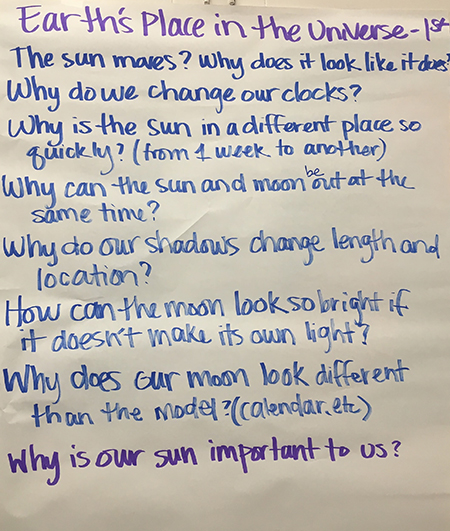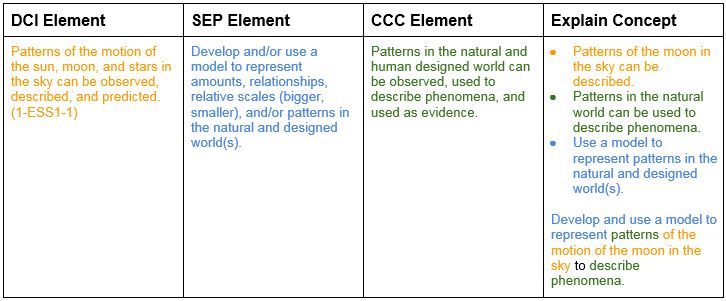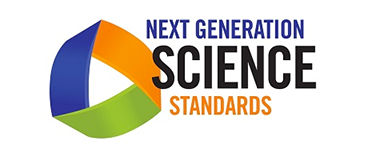K-12 Alliance Teaching Learning Collaborative: Nuts and Bolts of a Lesson Study
By Rachael Tarshes
San Diego Unified School District is one of eight districts and two charter management organizations across California participating in the CA NGSS K-8 Early Implementation Initiative. One of the essential components of our work as part of the Initiative is the lesson study, which is intended to deepen understanding of the NGSS and transform teacher practice. The K-12 Alliance has developed a professional learning strategy for this termed the Teaching Learning Collaborative (TLC) (K-12 Alliance, 2017). All participating teachers experience two cycles of TLC each school year, i.e., one in the fall and one in the spring. Each TLC cycle is composed of two full days of collaborative, grade-alike work, aimed at producing learning sequences aligned with the conceptual shifts called for in the Next Generation Science Standards (NGSS) (NGSS Lead States, 2013).
Day One
On day one of the TLC cycle, the team of three to four teachers works collaboratively with a facilitator (a trained K-12 Alliance Regional or Project Director or member of our science leadership team called the Core Leadership Team) to develop a 5E learning sequence (Bybee, R. W., et al., 2006) that will be taught at a future date, one to two weeks later. Once logistics of when and where to teach have been determined, teachers work to identify a phenomenon that will be appropriate for their grade level and science content.

This starts by thinking about the content and thinking about what a student might wonder about that topic. Teachers share out what they think students might “wonder” about the topic and chart questions they think students might ask - or have asked - about that topic. Teachers can also add questions they might have. Here is an example of a student and teacher wondering chart from a 1st-grade team, who is designing a learning sequence related to the Disciplinary Core Idea: Earth’s Place in the Universe.
From this list of wonderings, the teachers then identify an appropriate anchoring phenomenon. An anchoring phenomenon must be a larger phenomenon that encompasses an entire unit of instruction, wherein students would need “in-depth understanding of several science ideas, as well as multiple lines of evidence and reasoning to adequately explain” the phenomenon (#ProjectPhenomena, n.d.). Careful selection of appropriate phenomena is integral to high-quality NGSS learning sequences. According to Achieve, Inc. (2016), “By centering science education on phenomena that students are motivated to explain, the focus of learning shifts from learning about a topic to figuring out why or how something happens’ (pg. 1). [The phenomenon the teachers selected from the above list of wonderings was The sun and moon follow predictable patterns.]
After a phenomenon is selected, teachers work individually to create a brainstorm, we call “Brainstorm Cluster Map”, by using large yellow sticky notes to write the science ideas they think students would need to explain the phenomenon after a unit of study. These science ideas are written as concept statements such as, “The moon orbits around the Earth”. Once everyone has written what they can, each teacher reads their ideas aloud and adds their sticky notes to a large chart paper that has the phenomenon written in the center. As each successive person shares their ideas, similar ideas can be clumped together.
The next steps involve many changes in sticky note color and resources. First, teachers use Appendix E of the NGSS to determine which Disciplinary Core Ideas (DCI) can be matched to the content concepts represented on the yellow sticky notes on the chart paper. Any DCIs that seem applicable are written in a shortened format on orange sticky notes and added to the chart paper. Any yellow content concept sticky note that does not have a matched DCI is evaluated to see if it should stay or if it should be taken off. One reason a sticky note might remain on the chart, even though it is not matched to a grade level DCI is that it is a concept from an earlier grade level that may or may not have been addressed in a previous year, but is foundational in a student developing an understanding of the science concepts needed to explain the chosen phenomenon, A sticky should be removed it the concept is from a higher grade level or does not have a connection to any DCI. This same process is repeated with Appendix F: Science and Engineering Practices (written on blue sticky notes) and Appendix G: Crosscutting Concepts (written on green sticky notes). [Appendices]

Brainstorm Cluster
Once these layers have been added to the growing concept map, similar content concepts and their linked Disciplinary Core Ideas (DCIs), Science and Engineering Practices (SEPs), and Crosscutting Concepts (CCCs) are clumped together and then the clumps are given numbers to delineate what would be taught first, second, last, etc. After everyone agrees on an order for instruction on their Brainstorm Cluster, all of the sticky notes are moved to a new chart and placed in a linear sequence to represent the order of instruction. The phenomenon with an embedded concept is moved to the top of this new chart to help focus the work and one of the clumps - a learning sequence - is selected (circled in red) to be a part of the TLC team’s teaching day. From this learning sequence, teachers identify an investigative phenomenon and place subconcepts in a logical order. The investigative phenomenon is the not be the same as the anchoring phenomenon, however, as it supports understanding and/or explanation of the anchoring phenomenon.

Chosen to Develop Into a
5E Learning Sequence
Once the whole learning sequence has been outlined on this chart, a single content concept (yellow sticky notes with attached blue, green, and orange sticky notes) is chosen for the lesson planning, which happens next.
For the lesson planning, the team works collaboratively to develop a 5E learning sequence, using the BSCS 5E Instructional Model, that is composed of different stages including engage, explore, explain, elaborate and evaluate (Bybee, R. W., et al., 2006). The learning sequence will also be taught collaboratively so it is important that all teachers actively participate in the development. The learning sequence plan template includes four columns, i.e., the 5E Stage, Teacher Does, Student Does, and 3-D Concepts for each stage of instruction.
The learning sequence plan starts in the “Explain” concept column. Part of the requirement for the TLC teaching day is that teachers have samples of student work in order to evaluate the effectiveness of their instruction. Most likely, whatever the students do in the “Explain” section will be what is evaluated. A key shift in the 5E “Explain” is that it is the students explaining what they know, not a time for the teachers to explain to the students the right answer or what they want them to know. With this in mind, and using their learning sequence with the chosen learning sequence concept from their Linear Storyline chart, teachers have a content concept, i.e., a DCI, a SEP and a CCC. With the three-dimensions in mind, the team asks, “What do we want students to be able to explain at the end of this learning sequence?” For the explain concept, the team further analyzes the three dimensions (DCI, SEP, and CCC) they were able to align to their learning sequence from the NGSS Appendices (NGSS Lead States, 2013). Here's an example of this revision from the same 1st grade Earth science learning sequence that came from the wonderings poster above.

Development of a Three-Dimensional Concept
Once the Explain concept column is complete, the team focuses on the Engage concept column and asks, “What prior knowledge do students have about the Explain concepts? What will students leave the Engage stage knowing/recalling?” Then comes the Explore section. In this stage of the learning sequence, students will be actively exploring new learning, so the team asks, “What concepts should students EXPLORE to connect prior knowledge in ENGAGE to the concepts in EXPLAIN?” After the concept column is complete, the team then works together to create a script for the three main sections, writing exactly what the teachers will say and do and also writing what the students will say and do, as well as Expected Student Responses (ESR). Usually, the teaching time is only an hour so the elaborate/extend and evaluate stages are drafted by the team and planned to be taught after the TLC cycle.
Day Two
On the teaching day, each member of the team presents a part of the learning sequence to students. While enacting the learning sequence, teachers use the collaboratively planned script with fidelity. As the teachers are teaching, the facilitator records teacher and student talk, noting exact teacher or student questions and responses as well as time increments. After the first round of teaching, everyone comes together to discuss the learning sequence and student work. The facilitator guides this discussion by first asking each teacher to reflect on what they thought was effective in the learning sequence. After everyone has shared, the facilitator then asks for anything that was less effective or did not work as planned. Once ideas are shared and charted, the team takes a look both the facilitator notes and at the student work. The team develops a preliminary rubric based on the “high” level of student work determined on the planning day. They analyze student work to find characteristics of medium and low performance and use this information to discuss how to move student understanding to a high level. Usually, the ideas for what students need to be more successful means editing the learning sequence plan.
With a revised scripted learning sequence in hand, the team teaches the second group of students. Again the facilitator records what teachers and students do and say.
After the second teaching, the group comes together for one last debrief. The team again starts with what was effective. Student work is again assessed using the revised rubric that was developed in the first debrief and links are made between learning sequence changes and changes in student understanding as represented seen in student work samples. The TLC ends with teachers sharing what they would do next for a follow-up learning sequence and what they would change if they could teach one more time.
A main goal of the CA NGSS K-8 Early Implementation Initiative is to share what has been useful in helping teachers implement the CA NGSS. Without question, we hear teachers comment that the TLC process was perhaps the most transformative piece for them. Teachers who experience the TLC process emerge enlightened and transformed.
“K12 has reinforced my belief that collaboration among teachers is important and how reflection and evaluation of lessons and student work are necessary for both student and teacher growth.”
~Sherri Stansbury - 7th & 8th Grade Science Teacher, Palm Springs Unified School District
"The TLC process is the best professional development my teachers have received in years. The K-12 Alliance is transforming instruction and giving opportunities to build teacher leadership on my site.”
~Cindy Anderson - Principal, Vista Unified School District
“Lesson studies, at the heart of the K12 Alliance work, focused on high-level collaborative norms, best-practices in instruction, and evidence-based analysis of instruction. This allows teachers to build positive, highly-effective personal and professional connections with each other while simultaneously giving teachers space and the challenge to do what really works for student inquiry and learning.”
~Ashley Holzhauer - Secondary Science Coach, Dublin Unified School District
For more information about how the TLC process deepens teacher understanding of the NGSS and transforms practice, check out the companion piece to this article: NGSS and the Teaching Learning Collaborative: It’s About the Process.
Rachael Tarshes is a Resource Teacher and Project Director for the CA NGSS K-8 Early Implementation Initiative for San Diego Unified School District and a member of CSTA. Email: rtarshes@sandi.net
References:
Achieve, Inc. (2016). Using Phenomena in NGSS-Designed Lessons and Units.
Bybee, R. W., et al. (2006). The BSCS 5E Instructional Model: Origins and Effectiveness. A Report Prepared for the Office of Science Education National Institutes of Health.
K-12 Alliance at WestEd. (2017). Teaching Learning Collaborative.
NGSS Lead States (2013). Next Generation Science Standards: For States, By States: NGSS Appendices, Washington, DC: The National Academies Press.
#ProjectPhenomena. (n.d.) Criteria for Selecting Useful Phenomena.







